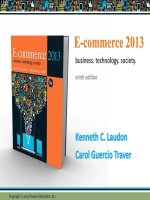Lecture E-commerce 2013: Business, technology, society (9/e): Chapter 2 - Kenneth C. Laudon, Carol Guercio Traver
Bạn đang xem bản rút gọn của tài liệu. Xem và tải ngay bản đầy đủ của tài liệu tại đây (1.24 MB, 42 trang )
E-commerce 2013
business. technology. society.
ninth edition
Kenneth C. Laudon
Carol Guercio Traver
Copyright © 2013 Pearson Education, Inc.
Chapter 2
E-commerce Business Models
and Concepts
Copyright © 2013 Pearson Education, Inc.
Objectives
Identify the key components of e-commerce
business models.
Describe the major B2C business models.
Describe the major B2B business models.
Explain the key business concepts and
strategies applicable to e-commerce.
Class Discussion
Tweet Tweet: What’s Your Business Model?
What characteristics or benchmarks can be used to
assess the business value of a company such as
Twitter?
Have you used Twitter to communicate with friends
or family? What are your thoughts on this service?
What are Twitter’s most important assets?
Which of the various methods described for
monetizing Twitter’s assets do you feel might be
most successful?
Copyright © 2013 Pearson Education, Inc.
Slide 2-4
E-commerce Business Models
Business model
Set of planned activities designed to result in a
profit in a marketplace
Business plan
Describes a firm’s business model
E-commerce business model
Uses/leverages unique qualities of Internet and
Web
Copyright © 2013 Pearson Education, Inc.
Slide 2-5
Eight Key Elements of a Business Model
1.
2.
3.
4.
5.
6.
7.
8.
Value proposition
Revenue model
Market opportunity
Competitive environment
Competitive advantage
Market strategy
Organizational development
Management team
Copyright © 2013 Pearson Education, Inc.
Slide 2-6
1. Value Proposition
“Why should the customer buy from
you?”
Successful e-commerce value
propositions:
Personalization/customization
Reduction of product search, price discovery
costs
Facilitation of transactions by managing
product delivery
Copyright © 2013 Pearson Education, Inc.
Slide 2-7
2. Revenue Model
“How will the firm earn revenue,
generate profits, and produce a superior
return on invested capital?”
Major types:
Advertising revenue model
Subscription revenue model
Transaction fee revenue model
Sales revenue model
Affiliate revenue model
Copyright © 2013 Pearson Education, Inc.
Slide 2-8
Insight on Society: Class Discussion
Foursquare Checks Out a Revenue Model
What revenue model does Foursquare use?
What other revenue models might be
appropriate?
Are privacy concerns the only shortcoming of
location-based mobile services?
Should business firms be allowed to call cell
phones with advertising messages based on
location?
Copyright © 2013 Pearson Education, Inc.
Slide 2-9
3. Market Opportunity
“What marketspace do you intend to
serve and what is its size?”
Marketspace: Area of actual or potential commercial
value in which company intends to operate
Realistic market opportunity: Defined by revenue
potential in each market niche in which company hopes
to compete
Market opportunity typically divided
into smaller niches
Copyright © 2013 Pearson Education, Inc.
Slide 2-10
4. Competitive Environment
“Who else occupies your intended
marketspace?”
Other companies selling similar products in the same
marketspace
Includes both direct and indirect competitors
Influenced by:
Number and size of active competitors
Each competitor’s market share
Competitors’ profitability
Competitors’ pricing
Copyright © 2013 Pearson Education, Inc.
Slide 2-11
5. Competitive Advantage
“What special advantages does your firm
bring to the marketspace?”
Is your product superior to or cheaper to produce than
your competitors’?
Important concepts:
Asymmetries
First-mover advantage, complementary resources
Unfair competitive advantage
Leverage
Perfect markets
Copyright © 2013 Pearson Education, Inc.
Slide 2-12
6. Market Strategy
“How do you plan to promote your
products or services to attract your
target audience?”
Details how a company intends to enter
market and attract customers
Best business concepts will fail if not
properly marketed to potential customers
Copyright © 2013 Pearson Education, Inc.
Slide 2-13
7. Organizational Development
“What types of organizational
structures within the firm are necessary
to carry out the business plan?”
Describes how firm will organize work
Typically, divided into functional departments
As company grows, hiring moves from
generalists to specialists
Copyright © 2013 Pearson Education, Inc.
Slide 2-14
8. Management Team
“What kind of backgrounds should the
company’s leaders have?”
A strong management team:
Can make the business model work
Can give credibility to outside investors
Has market-specific knowledge
Has experience in implementing business plans
Copyright © 2013 Pearson Education, Inc.
Slide 2-15
Insight on Business: Class Discussion
Is Groupon’s Business Model
Sustainable?
What is the value of Groupon to merchants?
What types of merchants benefit the most?
What is the value of Groupon to investors?
Is Groupon overvalued ?
What obstacles does Groupon face?
Which competitors present the greatest
threat to Groupon?
Copyright © 2013 Pearson Education, Inc.
Slide 2-16
Categorizing E-commerce
Business Models
No one correct way
Text categorizes according to:
E-commerce sector (e.g., B2B)
E-commerce technology (e.g., m-commerce)
Similar business models appear in more than
one sector
Some companies use multiple business
models (e.g., eBay)
Copyright © 2013 Pearson Education, Inc.
Slide 2-17
B2C Business Models
E-tailer
Community provider (social network)
Content provider
Portal
Transaction broker
Market creator
Service provider
Copyright © 2013 Pearson Education, Inc.
Slide 2-18
B2C Models: E-tailer
Online version of traditional retailer
Revenue model: Sales
Variations:
Virtual merchant
Bricks-and-clicks
Catalog merchant
Manufacturer-direct
Low barriers to entry
Copyright © 2013 Pearson Education, Inc.
Slide 2-19
B2C Models: Community Provider
Provide online environment (social
network) where people with similar
interests can transact, share content,
and communicate
e.g., Facebook, LinkedIn, Twitter, Pinterest
Revenue models:
Typically hybrid, combining advertising,
subscriptions, sales, transaction fees, affiliate
fees
Copyright © 2013 Pearson Education, Inc.
Slide 2-20
B2C Models: Content Provider
Digital content on the Web
News, music, video, text, artwork
Revenue models:
Subscription; pay per download (micropayment);
advertising; affiliate referral
Variations:
Syndication
Web aggregators
Copyright © 2013 Pearson Education, Inc.
Slide 2-21
Insight on Technology: Class Discussion
Battle of the Titans: Music in the Cloud
Have you purchased music online or subscribed to a
music service? What was your experience?
What revenue models do cloud music services use?
Do cloud music services provide a clear advantage
over download and subscription services?
Of the cloud services from Google, Amazon, and
Apple, which would you prefer to use, and why?
Copyright © 2013 Pearson Education, Inc.
Slide 2-22
B2C Business Models: Portal
Search plus an integrated package of
content and services
Revenue models:
Advertising, referral fees, transaction fees,
subscriptions
Variations:
Horizontal/General
Vertical/Specialized (Vortal)
Search
Copyright © 2013 Pearson Education, Inc.
Slide 2-23
B2C Models: Transaction Broker
Process online transactions for
consumers
Primary value proposition—saving time and money
Revenue model:
Transaction fees
Industries using this model:
Financial services
Travel services
Job placement services
Copyright © 2013 Pearson Education, Inc.
Slide 2-24
B2C Models: Market Creator
Create digital environment where
buyers and sellers can meet and
transact
e.g.,
Priceline
eBay
Revenue model: Transaction fees
Copyright © 2013 Pearson Education, Inc.
Slide 2-25









